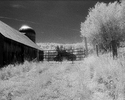HQ reacts with Oxygen giving Quinone which reacts with Sodium Sulfite giving HQ-Mono Sulfonate and Hydroxide ion which causes the pH to rise slightly. The explanation here is perhaps an oversimplification, but is for you non-chemists. Mees, Mees and James and Haist all discuss this with chemical symbols and the whole detailed agonizing organic chemistry stuff.
This change though, causes a very tiny increase in activity due to the rise in pH but the loss in HQ is what prevents it from being a huge change. Also, the Oxygen dissolved in the water is used up. In the long run, the developer stabilzes and everything is OK. Usually, I let my D-76 sit for 24 hours before use and this damps out the problem.
There are errors on the web site referenced above, so beware as it is hard for one to separate the wheat from the chaff there. This has been commented on here before by other APUG members.
PE











